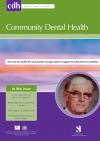Community Dental Health

- Cover Date:
- March 2012
- Print ISSN:
- 0265 539X
- Vol:
- 29
- Issue:
- 1
Development and testing of a theory-based behavioural change intervention: A pilot investigation in a nursery school in a deprived area of Scotland
doi:10.1922/CDH_2707Gilinsky06
Objective: Investigate the effect of a theory-based intervention on oral-health knowledge, attitudes and behaviours of early years staff (EYS), parents and nursery children. Methods: Qualitative research with staff and parents from eight nurseries through interviews/focus groups. An intervention was developed and piloted using pre-posttest design. Clinical setting: Nurseries in deprived communities in Dundee, Scotland. Participants: 111 children aged 3-5 years attending nursery, including 79 parents and 8 nursery staff. Interventions: Staff session targeted outcome expectancies, subjective norms and self-efficacy for tooth-brushing in nursery using information provision, modelling and goal-setting, followed by a three-week intervention. Parent-child dyads received a leaflet with instructions for goal-setting, planning and monitoring home brushing. Tooth-brushing self-monitoring materials (e.g. two-minute timer, diaries) were used and certificates provided in the nursery as rewards. Outcome measures: EYS knowledge, attitudes and behaviours were assessed before and after the intervention using self-report questionnaires. Parents completed interviews assessing beliefs about tooth-brushing and their children’s tooth-brushing behaviour at baseline and post-intervention follow-up. Results: Significant improvements in staff knowledge, but not attitudes, self-efficacy, or nursery tooth-brushing were reported. Parent-child dyads completing the intervention were not more likely to report their child carried out twice-daily tooth-brushing at home. The intervention did not improve parents’ intentions to brush their child’s teeth twice a day or beliefs about the ease of twice-daily tooth-brushing. Conclusion: Only past behaviour significantly predicted posttest brushing. Parents who found brushing easier at baseline were more likely to complete the intervention. Recommendations are made regarding implementing psychological theory and methods into oral-health interventions.
Key words: child, dental caries, knowledge, behaviour, attitudes, parents, nurseries, intervention, health inequalities.
- Article Price
- £15.00
- Institution Article Price
- £0.00
- Page Start
- 62
- Page End
- 67
- Authors
- A. Gilinsky, V. Swanson, M. Merrett, K. Power, L. Marley
Articles from this issue
- Title
- Pg. Start
- Pg. End
- The caries experience of 11 to 12 year-old children in Scotland and Wales and 12 year-olds in England in 2008-2009: Reports of co-ordinated surveys using BASCD methodology
- 8
- 13
- Variations in caries diagnoses and treatment recommendations and their impacts on the costs of oral health care
- 25
- 28
- Associated factors of tooth wear among Malaysian 16-year-olds: a case-control study in Kota Bharu, Kelantan
- 33
- 38
- Factors associated with self-assessed masticatory ability among community-dwelling elderly Japanese
- 39
- 44
- Development and testing of a theory-based behavioural change intervention: A pilot investigation in a nursery school in a deprived area of Scotland
- 62
- 67
- Illness-related behaviour and sociodemographic determinants of oral health care use in Dabou, Côte d’Ivoire
- 78
- 84
- Perception of oral health related quality of life (OHQoL-UK) among periodontal risk patients before and after periodontal therapy
- 90
- 94
- Dental Fluorosis, Dental Caries, and Quality of Life Factors among Schoolchildren in a Colombian Fluorotic Area
- 95
- 99
- Relationship of Periodontal Disease to Pre-term Low Birth Weight Infants in a Selected Population - A Prospective Study.
- 100
- 105
- Orofacial pain symptoms and associated disability and psychosocial impact in community-dwelling and institutionalized elderly in Hong Kong
- 110
- 116
- Association of hyposalivation with oral function, nutrition and oral health in community-dwelling elderly Thai
- 117
- 123
- Assessment of the relationship between perceptions of dental aesthetics and demand for orthodontic treatment in 10 – 11 year old school children in Birmingham, UK.
- 124
- 128
